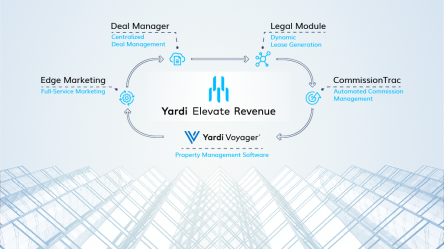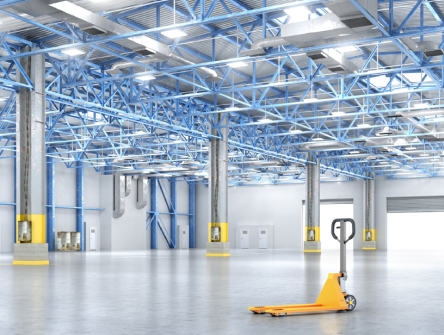Yardi has launched Elevate Revenue, a CRE solution stack that streamlines the entire deal lifecycle from lead to lease. Specifically intended for owners, asset managers and leasing teams, the all-in-one solution was designed in collaboration with commercial experts and industry leaders. The end-to-end portfolio management suite, supported by decades of real estate research and software development knowledge, optimizes the deal workflow through powerful automation, enhanced team collaboration and extensive insights. Providing unmatched portfolio visibility, Elevate Revenue seamlessly integrates marketing, leasing system and commission management tools into one centralized platform. With Edge Marketing, real estate professionals can effortlessly market listings and generate verified leads through Yardi’s rapidly growing CommercialEdge Listing Network. From there, Deal Manager further streamlines leasing operations by enabling users to smoothly manage prospects and oversee each stage of the deal flow, while automatically comparing deal economics to approved budgets and prior leases. Additionally, to simplify the legal process and easily track legal documents, the Elevate suite includes Deal Manager Legal Module, an intuitive tool that allows users to automatically generate standard lease agreements directly in the application. And it doesn’t stop there. CommissionTrac, Yardi’s commission management tool, efficiently rounds out the leasing process by automatically tracking and paying the commissions of both in-house and third-party brokers. Elevate Revenue is fully integrated with Yardi Voyager thanks to Yardi’s built-in CRM — this smooth connection ensures maximum portfolio and deal pipeline oversight in real-time. Voyager clients can sync properties, spaces and availability across their portfolio. Listings are automatically published based on lease expiration dates or automatically unpublished once a tenant is activated for a specific space in Voyager. In October, Macerich — an owner, operator and developer of retail and mixed-use destinations throughout the U.S. — leveraged Deal Manager and Edge Marketing solutions to...
Office Outlook
From CommercialEdge
The September jobs report clearly left something to be desired, adding just 194,000 jobs for the month. However, a brighter point is within that number: Nearly half of all of the jobs added in September were in the office-using sector. And, while many more jobs are needed to rebound to pre-pandemic levels, data from the CommercialEdge National Office Report is encouraging. Nationwide, office vacancy rates continued their slow trickle downward, falling 50 basis points (bps) in September to settle at 14.9%. Moreover, vacancy rates are still up 130 bps year-over-year. At the same time, the national average full-service equivalent listing rate for all office space dropped $0.10 over August figures. Even so, it still represents a 1.2% year-over-year increase. Specifically, 18 of the top 25 markets analyzed experience an increase in listing rates. They were led by Los Angeles and the Bay Area, which saw increases of 8.1% and 6.2% year-over-year, respectively, to $41.62 and $55.79. Meanwhile, listing rates in the Indianapolis office space market cooled ever so slightly over August figures, finishing the month at $21.09 — down 0.29% year-over-year. However, as the pandemic wanes and becomes more endemic, there are reasons to be optimistic regarding commercial real estate. In particular, big tech companies have been on a buying spree of large and high-profile office buildings. For instance, Google will exercise its purchase option at Hudson Yards in New York City for $2.1 billion; Apple purchased a trio of buildings in Cupertino, Calif., for $450 million; and Amazon continues construction on its $2.5-billion HQ2 headquarters in Northern Virginia. Notably, part of the motivation for purchasing commercial real estate is also driven by record levels of cash reserves at large technology companies. And, historically low interest rates combined with record profits means that commercial...
Office Outlook
Life Sciences a Bright Point
Lately, most news seems to be centered around when workers will be returning to the office. But, according to the September CommercialEdge National Office Report, the U.S. office real estate market is also warming up again after cooling off of 2020. While August vacancy rates nationwide are still 210 basis points (bps) below their August 2020 levels, they’re also ticking steadily downward, sinking another 10 bps to 15.4% compared to July. Meanwhile, the national average full-service equivalent listing rate for all office space was $38.72 per square foot in August — an increase of 1.2% year-over-year. Even so, seven of the top 25 markets analyzed experienced a contraction in listing rates: Listings in Manhattan and Chicago fell 2.9% and 1.7%, respectively, while Seattle office space vacancy rates notched 6.8% higher — one of the largest year-over-year increases of the markets analyzed. Essentially, the life sciences sector is the only consistent bright point throughout the pandemic. In fact, it’s grown faster in the last 18 months than before the pandemic started. However, more than half of the office space in this sector is concentrated in just four markets: Boston, San Diego, San Francisco and the Bay Area. These markets are prime arenas for the life sciences industry due to the presence of top universities like Stanford, MIT and Harvard that provide not only research opportunities, but also a large talent pool, as well. Furthermore, Boston alone has 7.2 million square feet of lab space under construction, with another 11.6 million square feet currently in the planning and prospective stages — and that doesn’t even include planned conversions. Granted, office construction is slowing across the nation and, although deliveries are holding steady, new starts are slowing down in almost every market. But, Austin, Texas, is a...
Industrial Thrives
Says CommercialEdge
Industrial real estate continues to see strong rent growth and high demand, driven by pandemic-prompted online shopping trends. Industrial rents averaged $6.44 per square foot in January, a 5.1% increase over the last 12 months, according to a new CommercialEdge Industrial National Report. Even as vaccinations ramp up and more people return to more normal-looking lives, demand for industrial is expected to stay strong. New leases signed in 2020 often included premium pricing, with the average rental rate for new leases signed in the last 12 months at $7.50 per square foot. The average vacancy rate was 6.0%. Continued demand for industrial space will sustain rent growth and drive vacancy rates lower. “We expect that demand will continue to increase even if e-commerce does not match its blistering 2020 growth rate. E-commerce has a continued role to play, and last year likely signaled a structural shift in consumer preferences more than temporary changes in behavior. Retail as we knew it has changed, and in its place warehousing and distribution have increased in importance,” say analysts. An improving global economy, ramped up trade volume and inventory replenishment for retailers will be additional drivers. Sector investment activity is healthy and growing as well. The fourth quarter of 2020 now has the highest sales volume of any quarter since Yardi Matrix began collecting industrial data, with $11.9 billion of sales completed. Properties fetched an average price per square foot of $100, an 18.2% increase year-over-year. Find more trend and data insights in the latest national industrial report from CommercialEdge. CommercialEdge provides extensive property data that includes transaction, ownership and debt information, offering nationwide coverage across all commercial real estate asset types. Use the platform to uncover vital market data and get insights with the latest lease and...
Office Outlook
Uncertainty remains
Office markets across the country faced a harsh year in 2020, and the outlook is still unclear, at least for the near-term. Vacancy rates ticked up 40 basis points to 14.2% and full-service-equivalent listing rates fell 1% nationally to $37.76 in the last 12 months, according to the January CommercialEdge National Office Report. Meanwhile, employment in office-using sectors has also largely been tracking the office space sector overall. Following a slight rebound in the summer and into early fall, employment is now falling again as the third wave of the virus drags on. Nationally, office-using employment fell 3.4% y-o-y in December. In fact, only 16 of the 120 markets covered in the report saw an increase in office-using employment, but most of them were under 2%. However, Austin’s office-using employment actually rose 6.4% in the last year, signaling a rosier outlook for Austin office space. Despite the overall downturn, new office construction still continued. Even though some projects were halted temporarily, 67.6 million square feet of office space was delivered nationwide in 2020. Currently, Charlotte and Austin stand out as both have the most square footage under construction — 11.5% and 10.8%, respectively, of their overall stock. “They both have high levels of domestic in-migration, and they have benefited from financial firm relocations. While New York City is still the financial capital of the world, financial jobs have been leaving for markets like Charlotte and Austin for years,” analysts noted in the report. “Much of the growth is driven by the financial activities sector, even though tech relocations capture most of the attention.” One aspect of the office’s uncertain future is related to how we’ll get back to normal. The vaccine rollout isn’t going as fast as many hoped, so a return to normalcy...
Industrial Outlook
Is looking good, says CommercialEdge
It’s a rosy outlook for the newest real estate sector to be featured in a CommercialEdge monthly report. In 2020, the industrial sector was considered the top performer of all major real estate sectors. Industrial rents averaged $6.38 per square foot in December 2020, a 4.8% increase over the last 12 months, according to the first-ever CommercialEdge Industrial Monthly. All of the top 20 markets covered in the report saw at least some measure of growth in average rent over the last year. The ongoing industrial report will cover data on rents, occupancy, supply and transactions, as well as key economic indicators. “Rent growth across the board bucks the trend of other commercial real estate asset classes. Both multifamily and office have a substantial share of markets with falling rents and increasing vacancies, something not seen among the top 20 industrial markets,” note the analysts. Demand for e-commerce infrastructure and a huge boost in online sales during the pandemic have been a boon for industrial assets. Today, e-commerce accounts for nearly one-fifth of core retail sales. In 2020, a record 228.4 million square feet of industrial space was delivered, the most new space completed this century. That milestone is a further indicator of the health of industrial real estate. These projects were well underway before COVID-19 induced a demand surge for industrial space, signifying that the industry was already on the upswing before 2020 put things into overdrive. Find the full CommercialEdge Industrial Monthly for...
Office Update
From CommercialEdge
With office listing rates falling, vacancies increasing and new development slowing, the impact of the COVID-19 pandemic on the U.S. office market is showing clearly after several months’ delay. The latest data, collected in the National Office Report from CommercialEdge powered by Yardi, shows that the national average full-service equivalent listing rate fell 25 cents in September from the previous month, to $38.07. This was a 0.5% decrease from the same period last year. The national vacancy rate increased 30 basis points month-over-month to 13.6%. “Listing rates have remained relatively sticky during the pandemic, with rates not decreasing concurrent with falling demand,” states the report. “The long-term nature of office leases coupled with a lack of potential tenants gives owners no incentive to dramatically lower rates at the current time.” Meanwhile, the amount of new office stock under construction has fallen steadily throughout the year. Only 24 of the top 75 markets analyzed have more square feet under construction than at the start of 2020. “As it becomes increasingly clear that things will not return to normal until a vaccine is made widely available, developers have not been replacing completed properties with new construction,” states the report. Gain all the insight in the October National Office Report from the research experts at CommercialEdge. CommercialEdge provides extensive property data that includes transaction, ownership and debt information, offering nationwide coverage across all commercial real estate asset types. Use the platform to uncover vital market data and get insights with the latest lease and sale listings. Want more key takeaways? Join the Office National Outlook webinar set for Wednesday, Nov. 11. Yardi Matrix vice president Jeff Adler and team will lead an informative presentation of the current trends and what to expect...







